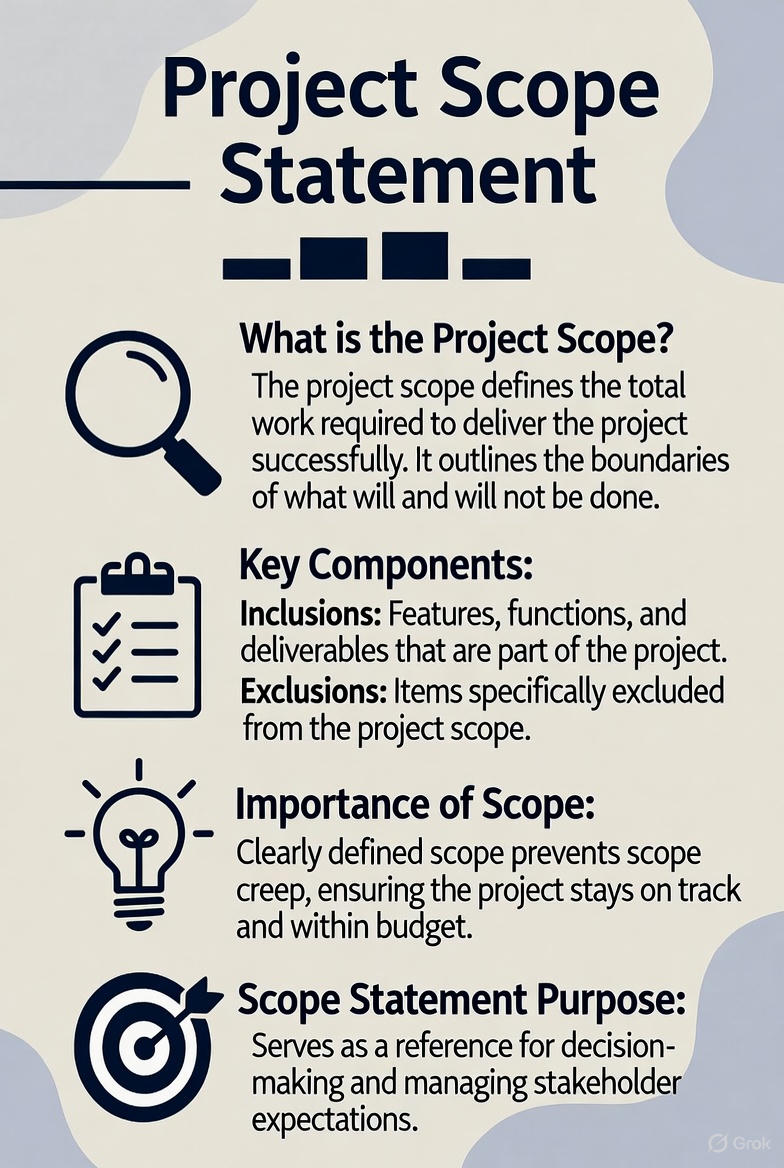- Version
- Download 3
- File Size 56.66 KB
- File Count 1
- Create Date November 4, 2025
- Last Updated November 12, 2025
What is a Project Scope Statement? A Definitive Guide
In the world of project management, few documents hold as much power and importance as the Project Scope Statement. But what exactly is it? At its core, a Project Scope Statement is a formal, documented description of the project's deliverables, objectives, and the specific work required to create them. It serves as the foundational blueprint that guides every subsequent decision and action. More than just a definition of work, it provides a common understanding of the project's boundaries among all stakeholders, from the project sponsor and team members to end-users and clients. Without a clear and agreed-upon Project Scope Statement, projects are vulnerable to misunderstandings, wasted resources, and the dreaded "scope creep," which can derail even the most well-intentioned initiatives.
Why a Project Scope Statement is Non-Negotiable for Project Success
The act of creating a robust Project Scope Statement is one of the most critical investments a project team can make. Its value extends far beyond the initial planning phase, providing a steady anchor throughout the project lifecycle. The primary benefits include:
- Establishing a Single Source of Truth: It creates a shared vision and a common understanding, ensuring that every stakeholder is aligned on the project's goals and deliverables from the very beginning. This prevents costly miscommunications and rework.
- Enabling Detailed and Accurate Planning: A clear scope enables the project team to perform more detailed planning. With a definitive list of deliverables and work requirements, managers can accurately estimate costs, develop realistic schedules, allocate resources effectively, and identify potential risks.
- Providing a Baseline for Control: During project execution, the Project Scope Statement directs the work of the team and, most importantly, provides a baseline for evaluation. When new requests or ideas emerge, the project manager and stakeholders can compare them against the documented scope to determine if they are contained within the original project boundaries or if they constitute a change that requires formal approval through a change control process.
- Proactively Managing Stakeholder Expectations: By explicitly listing what is included and, just as crucially, what is excluded from the project, the Project Scope Statement manages stakeholder expectations. This transparency helps prevent assumptions and reduces the potential for conflict and disappointment later in the project.
Deconstructing the Key Components of a Powerful Project Scope Statement
A comprehensive Project Scope Statement is more than a few bullet points; it's a detailed narrative of the project's boundaries. Key components must be included to make it effective:
- Project Objectives: The specific, measurable, achievable, relevant, and time-bound (SMART) goals the project aims to fulfill.
- Project Deliverables: A detailed description of all tangible and intangible outputs, products, or capabilities that will be produced. This could include everything from a new software feature and a constructed building to a completed report or a new business process.
- In-Scope Items: A clear and detailed description of the work that is explicitly included to produce the agreed-upon deliverables.
- Exclusions (Out-of-Scope Items): This is a critical section for managing expectations. It contains explicit exclusions from the scope, clearly stating what the project will not deliver. For example, a project to develop a website might explicitly exclude ongoing content creation or digital marketing services.
- Technical Requirements: Any specific technologies, platforms, or performance criteria that the deliverables must meet.
- Constraints & Assumptions: Constraints are limiting factors (e.g., a fixed budget, a hard deadline, or specific technology). Assumptions are factors considered to be true for planning purposes, which, if proven false, could impact the scope.
- Acceptance Criteria: The specific conditions that must be met for a deliverable to be considered complete and accepted by the customer or sponsor.
The Project Scope Statement Within the PMBOK® Guide Framework
The importance of the Project Scope Statement is formally recognized in leading project management standards. It is a key output of the scope definition process, which is a central part of the Project Scope Management knowledge area.
- It is explicitly defined as the Output of the process 5.3 Define Scope in the PMBOK® Guide Sixth Edition. This process follows the collection of requirements and is the step where the preliminary project scope is refined into a detailed description.
- Similarly, it is identified as the Output of the process 5.4 Define Scope in the Process Group: A Practice Guide, underscoring its universal role as a fundamental practice across different project management methodologies.
Conclusion: More Than a Document, A Commitment
In conclusion, the Project Scope Statement is not merely a bureaucratic hurdle to be cleared at the start of a project. It is a living document that embodies the project's purpose and boundaries. It is a tool for communication, a shield against scope creep, and a roadmap to successful delivery. By investing the time and effort to create a detailed, unambiguous, and agreed-upon Project Scope Statement, project managers significantly increase their chances of leading their teams to a successful and conclusive finish, on time and within budget.
Call to Action:

